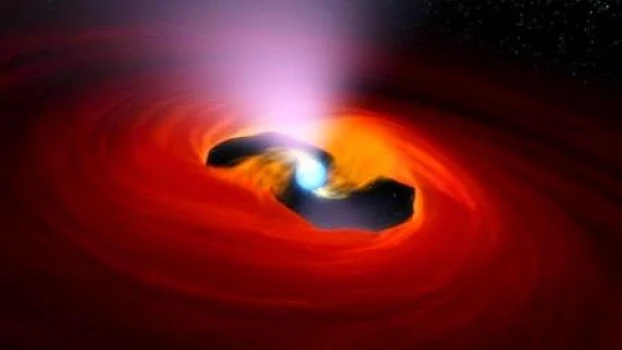Οι
ερευνητές έδωσαν στη δημοσιότητα μια εικόνα στην οποία μέσα στον κύκλο
διακρίνεται η περιοχή του γαλαξία Μ82 όπου εντοπίστηκε το υπέρλαμπρο πάλσαρ και
στον ένθετο κύκλο η περιοχή αυτή εμφανίζεται σε μεγέθυνση. Astronomers
working with NASA's Nuclear Spectroscopic Telescope Array (NuSTAR) have found a
pulsating dead star beaming with the energy of about 10 million suns. The
object, previously thought to be a black hole because it is so powerful, is in
fact a pulsar -- the incredibly dense rotating remains of a star. High-energy X-rays
streaming from a rare and mighty pulsar (magenta) can be seen in this new image
combining multi-wavelength data from three telescopes. The bulk of galaxy M82
is seen in visible-light data captured by the National Optical Astronomy
Observatory's 2.1-meter telescope at Kitt Peak in Arizona. Starlight is white,
and lanes of dust appear brown. Low-energy X-ray data from NASA's Chandra X-ray
Observatory are colored blue, and higher-energy X-ray data from NuSTAR are
pink. Credit: NASA/JPL-Caltech/SAO/NOAO
Μια
εντυπωσιακή ανακάλυψη έκανε ομάδα ερευνητών με επικεφαλής τον Ματέο Μπατσέτι
του Αστεροσκοπείου του Κάλιαρι στην Σαρδηνία. Οι ερευνητές χρησιμοποίησαν το
διαστημικό τηλεσκόπιο Nustar
και εντόπισαν ένα υπέρλαμπρο άστρο νετρονίου.
This mosaic image
of the magnificent starburst galaxy, Messier 82 (M82), is the sharpest
wide-angle view ever obtained of M82. It is a galaxy remarkable for its webs of
shredded clouds and flame-like plumes of glowing hydrogen blasting out from its
central regions, where young stars are being born 10 times faster than they are
inside in our Milky Way Galaxy. Image courtesy of NASA, European Space Agency,
and the Hubble Heritage Team (STScI/AURA)
Το
άστρο αυτό βρίσκεται στον γειτονικό γαλαξία Μ82, γνωστό και ως «γαλαξίας
πούρο», που βρίσκεται σε απόσταση 12 εκατομμυρίων ετών φωτός από εμάς. Σύμφωνα
με τους ερευνητές αυτό το άστρο νετρονίου έχει φωτεινότητα παρόμοια με εκείνη
δέκα εκατομμυρίων άστρων σαν τον Ήλιο και είναι το λαμπρότερο άστρο νετρονίου
που έχει εντοπιστεί μέχρι σήμερα στο Σύμπαν. Η ανακάλυψη
δημοσιεύεται στην επιθεώρηση «Nature».
Τα πάλσαρ
This artist's
illustration shows a black hole (center of disk) with matter from a massive
companion star falling onto it. Objects like this are thought to make up the
"ultraluminous X-ray source," or ULX, population, but recently one
ULX was found to be a dead star called a pulsar, not a black hole. Credit:
Optical: DSS; Illustration: NASA/CXC/M.Weiss
Ένα
από τα αποτελέσματα μιας έκρηξης σουπερνόβα είναι ο σχηματισμός σωμάτων υψηλής
πυκνότητας τα οποία ονομάστηκαν άστρα νετρονίου ή «πάλσαρ». Όλα τα πάλσαρ
εκπέμπουν δέσμες ακτινοβολίας από τους πόλους τους και καθώς περιστρέφονται,
γίνονται ορατά από τη Γη ως περιοδικές, σύντομες λάμψεις.
This animation
shows a neutron star—the core of a star that exploded in a massive supernova.
This particular neutron star is known as a pulsar because it sends out rotating
beams of X-rays that sweep past Earth like lighthouse beacons. (Credit:
NASA/JPL-Caltech)
Τα
πάλσαρ εκπέμπουν την ακτινοβολία (είτε ραδιοκύματα, είτε ακτινοβολία γ, είτε
ακτίνες Χ) με σταθερό ρυθμό. Ορισμένοι μάλιστα τα περιγράφουν ως «κοσμικούς
ραδιοφάρους».




Δεν υπάρχουν σχόλια:
Δημοσίευση σχολίου